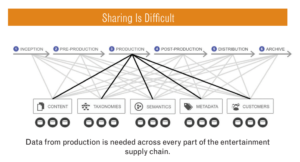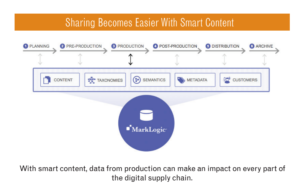Connections

M&E Journal: Tackling Data to Create Smart Production
Story Highlights
By Matt Turner, CTO Media & Entertainment, MarkLogic Corporation –
Not taking advantage of the data around content has never had bigger consequences for media organizations. It can keep them from creating great experiences and delivering the right content to partners. More than that, it can make it hard to optimize operations, get insight into the content’s value and stay ahead of the many changes in how content is created, consumed and monetized.
As the production process goes digital, this valuable data is increasingly being generated on the set. But, instead of making it easier to take advantage of this data, the new digital production tools are actually making it harder to access.
The result is that the data generated on set isn’t available within the production process and often has to be recreated or manually sourced to make an impact on the business.
Using a “smart content” approach, pioneers in the space are proving that data from production can be used in operations to reduce complexity on the set, drive reporting and enable media organizations to stay ahead of the many changes in the industry.
Production data today: Today’s production environments are making increasing use of digital tools and cloud management for every aspect of the production process. From contract systems to start the process, to script, set and wardrobe systems, digital tools are replacing the paper processes on the set and making it easier to execute each individual task.
However, because these tools are tailored to each individual task, the data they generate is specific to each task. This makes it very difficult to share the data and use it in operations.
Not having access to this data can make it difficult for M&E organizations to:
1. Make production more efficient: using data to optimize the processes and create of efficiencies by reducing data re-entry on set.
2. Better manage production: automate accounting and business management, including tracking appearances and product placements.
3. Use production data for distribution: enabling the business to take advantage of new revenue opportunities such as digital product placements or new interactive user experiences such as deep dives into the information behind the film.
 Because the data is in separate systems and in separate formats, the processes to use this data today include:
Because the data is in separate systems and in separate formats, the processes to use this data today include:
1. Email: extracting the data from a system and emailing to whomever needs it. While immediately effective, this results in an uncontrolled information environment that includes complex and sensitive data. For example, to convey details needed for travel, someone might send an actor’s entire contract, sharing potentially sensitive information without any controls.
2. Rekeying for re-use: it was reported at an industry conference that descriptive metadata is re-keyed up to 22 times during the production and distribution of the asset. This includes re-entering data for each tool on set and then re-creating the data as the film goes from production to distribution. This extra effort can not only add time and cost to managing data, but introduce errors and inconsistency that need to be double-checked as the data is used for revenue driving processes in distribution and online experiences.
3. Point to point connections: creating data links between systems is possible, but because data is specific to each function, it has to be mapped and transformed before it can be shared. This is a costly and time-consuming process. With the number of tools generating and collecting data on the set growing into the 100s and the mix often custom for each production, this approach can only cover a few key systems and can’t capture all the data generated on set.
These approaches make the process of managing data in production a time-intensive effort that results in extra effort, introduces data security risks and adds complexity.
The result is that while film production has made the shift to digital, the new technology often winds up bogging down the crew and making it harder to create great content.
Putting it together
To better take advantage of this data, production teams need a way to bring all this data together.
The first step is to be able to link the data generated by the production tools. IDs like EIDR can define the production itself. Techniques like the C4 (the Cinema Content Creation Cloud, an open source framework for content creation—www.cccc.io) can be used to generate a map of the data generated on the set.
To make the data operational, the data needs to be integrated. This means describing and recording the relationships between the contracts and schedules that put everyone on the set. And then integrating the scripts, wardrobe and prop management tools that define the action and the setting for each take.
Traditional approaches to integrating data are aligned around relational database technology. These approaches require every piece of data to be predefined in advance and for extract, transform and load (ETL) processes to be created to move the data from the source system to a new database.
These approaches fall short in production data environments. New tools are regularly being added and each production creates its own custom environments. Defining how data from each of these new tools must fit together ahead of time would be a potentially impossible task. Having to change it each time a new tool or data source is added could mean spending more time managing the data than actually creating the content.
Smart content approach
Instead of struggling with traditional approaches, production companies are turning to “smart content” —a combination of enterprise NoSQL database and semantic technology.
With smart content, the schema flexibility of enterprise NoSQL enables data to be stored closer to the way it’s actually used. Data can be loaded as-is instead of defining relational-style rows and columns ahead of time.
To make the connections between the data, including linking the production information to the action on the set for each take, smart content uses semantic data to record the relationships between the data.
Bringing the data from production together with a smart content approach enables production companies to, for the first time, integrate the many different sources of data generated in production and make that data operational.
 Production data impact
Production data impact
In the spring of 2016, the Entertainment Technology Center at the University of Southern California sponsored a film project to explore the possibilities of digital tools in production. The Suitcase, a short film, was created using digital applications to manage the production, the cloud for storage and smart content to demonstrate reuse of the production data.
A major proof point in the project was to determine if descriptive metadata from production applications could be collected and made available for reuse instead of having to re-create that data.
Using a smart content approach, the team integrated data from the many tools used in production. They aligned the script, scene, cast and set data to takes. Using this data, the team built an application enabling users to explore data behind the film at any point while watching the film —all directly powered by the data generated in production.
New Regency experiment
Building on the lessons from The Suitcase project, the team at New Regency used smart content to tackle several additional key challenges in production: coordinating the flow of data on the set, and accurately reporting residuals and product placement.
On today’s set, data sharing is largely through email and manual data re-entry. Business reporting, including critical financial tasks such as the reporting of actor appearances in the film and product placements, was often manually done after the film’s completion.
Taking a smart content approach, the team at New Regency created a metadata hub that linked the data from the key onset systems, including those for production management, contractual terms, the script, physical asset management, media management and editing.
This enabled the data to be shared between systems without manual effort. And using the integrated data, they were able to automate operational reports including those for residuals.
This process was done manually because the data from production about which actors appear in which take was not available in post production and editing. Instead, the teams had to record this information by having teams watch the film and record appearances.
By using smart content in production, New Regency was able to automate reports based on the production data for not just residuals for also for product placements.
Conclusion
The data around content is more important than ever for entertainment organizations and much of that data is now generated on the set with the advent of digital tools. However, with these new tools, the data generated can cause increased management complexity, sharing challenges, and difficulty in using that data for operations.
Using a smart content approach, leading edge production teams are showing that production data can be used to streamline the operations on the set, automate business operations and be used to power distribution. The result is that by better managing the data in production, these teams are able to avoid getting bogged down in the technology on the set and get back to making great content.
—
Click here to translate this article
Click here to download the complete .PDF version of this article
Click here to download the entire Spring 2017 M&E Journal









